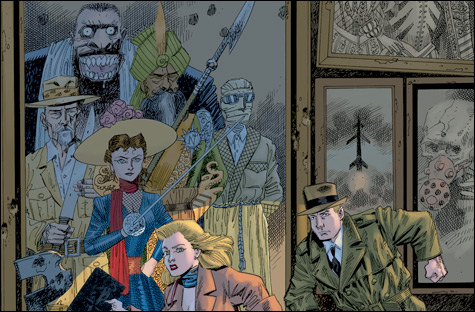
EPOCHAL: In Black Dossier, writer Alan Moore is the fanboy as grad student. |
| The League of Extraordinary Gentleman: Black Dossier | By Alan Moore and Kevin O’Neill | America’s Best comics | 208 pages $29.99 |
The third volume of writer Alan Moore & illustrator Kevin O’Neill’s multi-generational popular-fiction mash-up, The League of Extraordinary Gentleman, is an amazing geegaw. This volume, the first published solely as a graphic novel, is the comic as fetish object.For those of you just joining our story, the LOEG, as it’s called, is a group of unusual individuals working for British intelligence. Its first incarnation, the Murray Group, owes its name to Mina Murray, née Harker, the heroine of Dracula, who has proved her exceptional strength by surviving the attentions of that ruler of the undead. Also in her group are Captain Nemo, the Invisible Man, the deranged killer Edward Hyde, and the man who becomes Mina’s lover, Allan Quatermain.
The idea was to weave the icons of popular fiction into a kind of master narrative. That suits Moore’s conspiratorial imaginings as well as his Poindexter’s impulse to show off his knowledge. In Black Dossier, he’s the fanboy as grad student. Borrowing from Graham Greene’s The Third Man and enlisting as one of the Dossier League members Virginia Woolf’s time-traveling, gender-switching hero(ine) Orlando, Moore and O’Neill range well beyond the literature of the fantastic. Prospero makes an appearance in this edition, as does Spenser’s Faerie Queene. 1984 is a major plot source, and there’s a young agent named Emma Night. Fans of The Avengers will remember that Mrs. Peel’s maiden name was Knight; perhaps the “K” has been dropped to suggest that the purposes of the government she serves are less noble than dark.
In this installment, it’s 1958, and Britain, having won the war against Adenoid Hynkel (the name Chaplin gave to Hitler in The Great Dictator) and overcome the Ingsoc government (i.e., Big Brother) that came to power after the war, is out to smother the dirty secrets its intelligence operatives of the past might spill. Mina Murray and Allan Quatermain — who dipped into a fountain of youth in a previous adventure and are now sprightlier than ever at, respectively, 84 and around 135 — steal the dossier containing those secrets and find themselves pursued by British agents.
The meat of the book is in that dossier. We see it as they do, reading documents that include a lost Shakespeare folio, a sequel to Fanny Hill, an intelligence report written by Bertie Wooster, a Beat novel, a “biography” of Orlando rendered in Classics Illustrated style, postcards from LEOG members, and even a Tijuana Bible of the kind of narcotizing porn Orwell imagined the masses being given.
It’s brilliant. It’s also a titanic pain in the ass to read. The insistence on period accuracy means we get pages of the sort of small, close-printed type that makes the most eagle-eyed feel headachy. And in some way it shortchanges O’Neill, since the periods covered by the dossier would afford him even greater opportunity to show off his mastery of epochs and milieux. (This installment has the shadowy fug that befits both noir and the gloom of post-war Britain.)
If there’s a parallel to Black Dossier, it’s A.S. Byatt’s Possession, a novel that kept everyone I know who read it happily turning pages — and skipping the chunks of epic poetry she kept interpolating. Black Dossier is not Moore’s best comic (as he himself has admitted), but it is an annoying, enthralling one-of-a-kind object, the marriage of geek and polymath, in which he’s the nerdiest guy in the room and the hippest.